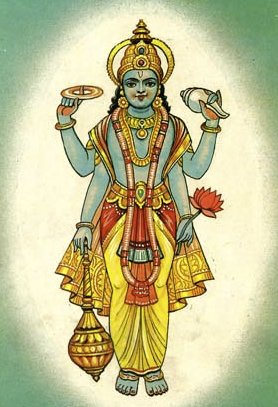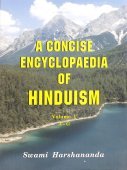Urdhvapundra, Ūrdhvapuṇḍra, Urdhva-pundra, Urdhvapumdra: 9 definitions
Introduction:
Urdhvapundra means something in Hinduism, Sanskrit. If you want to know the exact meaning, history, etymology or English translation of this term then check out the descriptions on this page. Add your comment or reference to a book if you want to contribute to this summary article.
In Hinduism
Purana and Itihasa (epic history)
Source: archive.org: Puranic EncyclopediaŪrdhvapuṇḍra (ऊर्ध्वपुण्ड्र).—A mark worn on the forehead with yellow ochre. This mark should be made by earth or ochre, which should be taken from the top of a mountain peak, banks of rivers, seashore, Śaivite temple serpent-hill or from under a holy basil. The fruits of wearing the mark will vary according to the colour of the ochre. Black ochre will afford peace, red soil will procure docility, yellow soil will get prosperity, and white ochre will give duty or righteousness. As the fruits vary according to the colour, so also it will vary according to the finger used to put the sign. If the mark is made with the thumb the man will become stout. If it is done with the middle finger he will have long life. If it is done with the fourth finger (anāmikā), he will get food and if it is made with the index finger (tarjanī) he will get salvation. The form of the mark also could be changed. The mark may be made in the form of a flame, the leaf of bamboo reed, a lotus-bud, a fish, a turtle or a conch. If the mark is as large as ten fingerbreadths it is superfine. If of nine finger-breadths, it is medium super-fine; and if it is eight and a half fingerbreadths, it is lower superfine. In the same way if the finger-breadth of the mark is seven, six or five they will be super medium, medium medium and lower medium. If it is four, three and two they will be of the low, medium low and lowest.
It is also ordered that when one wears the Ūrdhvapuṇḍra in a particular spot of the body one will have to think of a particular name of Viṣṇu.
"Keśava in the forehead, Nārāyaṇa in the stomach, Mādhava in the heart, Govinda in the neck, Viṣṇu on the right side of the stomach, Madhusūdana on the middle of right hand, Trivikrama on the left ear, Vāmana on the left side of stomach, Śrīdhara on the left hand, Hṛṣīkeśa on the right ear. Padmanābha on the hinder Part, Dāmodara on the nape and Vāsudeva on the head, should be meditated upon." (Devī Bhāgavata, Skandha 11).
Source: Cologne Digital Sanskrit Dictionaries: The Purana IndexŪrdhvapuṇḍra (ऊर्ध्वपुण्ड्र).—A caste mark on the forehead.*
- * Brahmāṇḍa-purāṇa IV. 38. 22.

The Purana (पुराण, purāṇas) refers to Sanskrit literature preserving ancient India’s vast cultural history, including historical legends, religious ceremonies, various arts and sciences. The eighteen mahapuranas total over 400,000 shlokas (metrical couplets) and date to at least several centuries BCE.
Vaishnavism (Vaishava dharma)
Source: Pure Bhakti: Arcana-dipika - 3rd EditionŪrdhvapuṇḍra (ऊर्ध्वपुण्ड्र) refers to “two vertical lines” (representing the temple of Śrī Hari), according to the Arcana-dīpikā (manual on deity worship).—Accordingly, while explaining the traditional procedure for applying tilaka:—[...] with the twelve mantras beginning with oṃ keśavāya namaḥ, apply tilaka to the twelve different parts of the body, beginning with the forehead, by drawing the ūrdhva-puṇḍra (two vertical lines) representing the temple of Śrī hari. Starting from the centre of the eyebrows, form two vertical lines on the forehead that reach up to the beginning of the hairline.
There must be a clean space in the middle of the ūrdhva-puṇḍra. From just below the centre of the eyebrows extending to three-quarters of the way down the nose is called the nāsāmūla. [This is where one forms the shape of a tulasī leaf.]
The ūrdhva-puṇḍra that is equal [in height] to the breadth of one’s ten fingers is considered topmost (uttama). that ūrdhva-puṇḍra that is equal to the breadth of one’s nine fingers is moderate (madhyama), and that which is equal to the breadth of one’s eight fingers is less than adequate (kaniṣṭha). the ūrdhva-puṇḍra (viṣṇu-tilaka) extends from three-quarters of the way down the nose up to the beginning of the hairline. [For gauḍīya Vaiṣṇavas, this tilaka consists of two lines on the forehead, with a marking the shape of a tulasī leaf on the nose.]

Vaishnava (वैष्णव, vaiṣṇava) or vaishnavism (vaiṣṇavism) represents a tradition of Hinduism worshipping Vishnu as the supreme Lord. Similar to the Shaktism and Shaivism traditions, Vaishnavism also developed as an individual movement, famous for its exposition of the dashavatara (‘ten avatars of Vishnu’).
Languages of India and abroad
Sanskrit dictionary
Source: DDSA: The practical Sanskrit-English dictionaryŪrdhvapuṇḍra (ऊर्ध्वपुण्ड्र).—a perpendicular sign of sandal on the forehead of a Brāhmaṇa.
Derivable forms: ūrdhvapuṇḍraḥ (ऊर्ध्वपुण्ड्रः).
Ūrdhvapuṇḍra is a Sanskrit compound consisting of the terms ūrdhva and puṇḍra (पुण्ड्र). See also (synonyms): ūrdhvapuṇḍraka.
Source: Cologne Digital Sanskrit Dictionaries: Cappeller Sanskrit-English DictionaryŪrdhvapuṇḍra (ऊर्ध्वपुण्ड्र).—[masculine] the perpendicular line on the forehead of a Brahman.
Source: Cologne Digital Sanskrit Dictionaries: Monier-Williams Sanskrit-English DictionaryŪrdhvapuṇḍra (ऊर्ध्वपुण्ड्र):—[=ūrdhva-puṇḍra] [from ūrdhva] n. = -tilaka above.
[Sanskrit to German]
Sanskrit, also spelled संस्कृतम् (saṃskṛtam), is an ancient language of India commonly seen as the grandmother of the Indo-European language family (even English!). Closely allied with Prakrit and Pali, Sanskrit is more exhaustive in both grammar and terms and has the most extensive collection of literature in the world, greatly surpassing its sister-languages Greek and Latin.
Kannada-English dictionary
Source: Alar: Kannada-English corpusŪrdhvapuṃḍra (ಊರ್ಧ್ವಪುಂಡ್ರ):—[noun] a sectarian mark (esp. of sandal paste), pointing upward, on the forehead.
Kannada is a Dravidian language (as opposed to the Indo-European language family) mainly spoken in the southwestern region of India.
See also (Relevant definitions)
Partial matches: Urdhva, Pundra.
Starts with: Urdhvapundradharana, Urdhvapundraka, Urdhvapundramahatmya, Urdhvapundrastotra, Urdhvapundravacana, Urdhvapundravidhi.
Full-text: Urdhvapundraka, Upavita, Pattavardhana, Tilaka, Vishnutilaka.
Relevant text
Search found 7 books and stories containing Urdhvapundra, Ūrdhvapuṇḍra, Urdhva-pundra, Urdhvapumdra, Ūrdhva-puṇḍra, Ūrdhvapuṃḍra; (plurals include: Urdhvapundras, Ūrdhvapuṇḍras, pundras, Urdhvapumdras, puṇḍras, Ūrdhvapuṃḍras). You can also click to the full overview containing English textual excerpts. Below are direct links for the most relevant articles:
The Skanda Purana (by G. V. Tagare)
Chapter 3 - Imprinting Marks of Conch etc. < [Section 5 - Mārgaśīrṣa-māhātmya]
Chapter 2 - The Application of Tripuṇḍra < [Section 5 - Mārgaśīrṣa-māhātmya]
Chapter 6 - Marks of Viṣṇu’s Devotee < [Section 1 - Veṅkaṭācala-māhātmya]
Chaitanya Bhagavata (by Bhumipati Dāsa)
Verse 1.15.8 < [Chapter 15 - Marriage with Śrī Viṣṇupriyā]
Verse 1.17.105 < [Chapter 17 - The Lord’s Travel to Gayā]
The Padma Purana (by N.A. Deshpande)
Chapter 21 - Restrictions While Observing the Kārtika Vow < [Section 4 - Brahma-khaṇḍa (Section on Brahman)]
Chapter 225 - The Efficacy of Ūrdhvapuṇḍra < [Section 6 - Uttara-Khaṇḍa (Concluding Section)]
Chapter 224 - Bearing the Marks of a Disc etc. Essential for a Brāhmaṇa < [Section 6 - Uttara-Khaṇḍa (Concluding Section)]
The Bhagavata Purana (by G. V. Tagare)
Chapter 25 - Dialogue between Kapila and Devahūti: Importance of the Bhakti-yoga < [Book 3 - Third Skandha]
Hindu Pluralism (by Elaine M. Fisher)
The Practical Applications of Textual Criticism < [Chapter 3 - Constructing Sectarian Identities in Early Modern South India]
The Shiva Purana (by J. L. Shastri)
Chapter 24 - The greatness of the holy ashes (bhasma) < [Section 1 - Vidyeśvara-saṃhitā]
Related products
